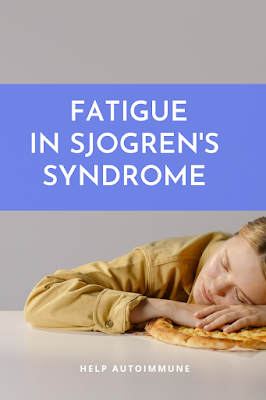The research data challenged the idea that proinflammatory cytokines directly cause fatigue in chronic immune conditions. "Instead, we hypothesise that mechanisms regulating inflammatory responses may be important."
Fatigue and Sjogren's Syndrome Frequently Asked Questions
What does Sjogren's fatigue feel like?
Think about the last time you had a really bad flu and your muscles felt weak and you could not even lift your head up off the pillow. That is how Sjogren's fatigue feels but it does not go away.
Many people with Sjogren's have tried to describe their fatigue because it is much more than normal tiredness and it cannot be cured by a good night's sleep.
In 2021 the Sjogren's Association in Europe created an awareness campaign about fatigue which they say is one of the most prevalent and disabling patient reported symptom of Sjögren’s. It is called 15 types of sjögren's fatigue. The core of the campaign is to express and raise awareness about patients' fatigue and the different ways it manifests itself. It provides words and shareable images about these types of fatigue in many languages. Here are some examples of 2 different types of Sjogren's fatigue: 2. Rebound fatigue
If I push myself too far and ignore the cues my body is sending me to stop and rest, my body will fight back. When I do more than I should, the result is an immobilizing fatigue. It comes on after the fact, i.e., do too much one day and feel it the next. If I push myself today, I very likely will have to cancel everything tomorrow. An extended period of doing more than I should will almost certainly cause a flare.
3. Sudden fatigue
This 'crumple and fold' phenomenon makes me resemble a piece of laundry. It comes on suddenly, and I have to stop whatever I'm doing and just sit down (as soon as I can). It can happen anywhere, at any time. It is the kind of fatigue that makes me shut off the computer in mid-sentence. It is visible to those who are observant and know what to look for, even though I make gargantuan efforts to disguise the fact that it is happening.
How is fatigue treated in patients with Sjogren's syndrome?
The unknown cause of fatigue in Sjogren's syndrome makes it difficult to determine a specific treatment for the symptoms. Synthetic or biological drugs have so far failed to show significant efficacy in improving fatigue. The role of HCQ remains unclear; RTX is questionable; LEF, zidovudine, bortezomib, TGP, belimumab, epratuzumab, abatacept, etanercept, and anakinra require further research. Other treatments such as dehydroepiandrosterone, gamma-linolenic acid, doxycycline, and infliximab are not effective based on available data. - 2019 research article 'Managing fatigue in patients with primary Sjögren’s syndrome: challenges and solutions.'
Hydroxychloroquine is HCQ.
Rituximab is RTX
Leflunomide is LEF.
Total glucosides of peony is TGP
The article goes on to say that aerobic exercise seems to be an effective and safe treatment suggestion and that sleep issues such as sleep apnea should be addressed.
How can I rate my fatigue?
You could use
the Fatigue Severity Scale (FSS) which is a rating scale used by doctors. It was designed to differentiate fatigue from clinical depression since both share some of
the same symptoms. The FSS is a short questionnaire that helps you record your own level of fatigue. You could use it each month to rate your fatigue and it would be helpful to show your rheumatologist, on your next appointment, if fatigue is one of your symptoms.
Get a copy in PDF form here.



The fatigue that I frequently feel is so intense that I'm afraid to go to sleep at night for fear that my body won't know how to breathe...
ReplyDeleteThank you so much for sharing this. That kind of fear—where even sleep feels unsafe—is something most people can’t imagine, but it’s real for many of us living with Sjögren’s and other chronic conditions. Fatigue isn’t just tiredness; it’s a full-body shutdown that can feel terrifying, especially when it messes with your breathing, your heart rate, or your sense of control.
DeleteYou’re not alone in this. That fear of “what if my body forgets how to breathe” is something I’ve heard from others too, and it deserves to be taken seriously—not dismissed or minimized. Our bodies carry so much, and sometimes the weight of that invisible struggle is heavier than anyone realizes.
If you ever want to share more about what helps you feel safer at night—or what you wish others understood—I’d be honored to listen. Your experience matters. You matter.